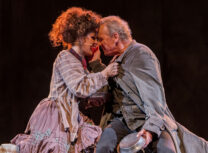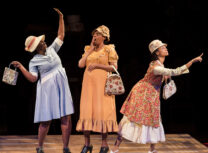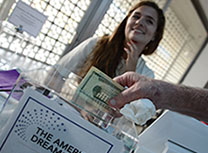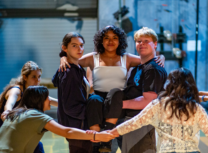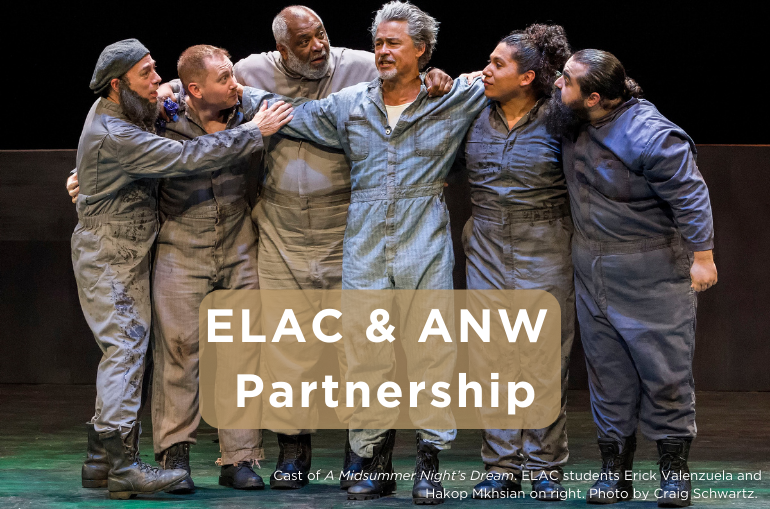Meet Scenic Designer Frederica Nascimento
By A Noise Within
June 17, 2016
You’ve probably seen Frederica’s spectacular designs on ANW’s stage (Tartuffe, The Threepenny Opera, All My Sons, Six Characters to name a few), now get to know ANW’s newest Resident Artist (and scenic designer for Arcadia and The Maids this fall)!
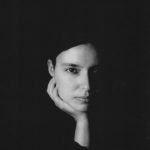 How long have you been designing with us?
How long have you been designing with us?
My first show with A Noise Within was in the Fall 2014. I was the scenic designer for Tartuffe by Molière, directed by Julia Rodriguez-Elliott.
What does being a Resident Artist mean to you?
It means the world to me. Sometimes in our professional life as freelance designers we find places that feel like home. The respect, admiration and collaboration with the members of the company are very real.
What makes ANW different than other theatres?
The rotating repertory at ANW presents unique challenges for scenic design. The satisfaction is in finding solutions to the challenges. The rotating repertory at ANW works because of the excellence, creativity and energy of the Artistic Directors, actors, staff and interns.
Are there any specific considerations you make when designing a set for rotating repertory?
Designing a set for rotating repertory is a big challenge and it helps me grow in my craft. At ANW three plays are presented simultaneously, therefore each designer is challenged in maximizing their space and at the same time sharing with the other designers. We make sure all scenic designers get the best of the theatre space in order to perfectly serve our final design.

What inspired you to become a scenic designer?
I always had a passion for theatre and film. I was always drawing, painting, building things around me and telling stories. I went to the Conservatory of the Arts to study set and costume design for theatre. The work of Teatro da Cornucópia and its artistic director Luís Miguel Cintra became my inspiration and mentor. I was working professionally as a scenic and costume designer when I decided to become an architect. I got involved in film when the legendary film director José Alvaro Morais saw my work with Rogério de Carvalho (Auto da India, Platonov, Spring Awakening, Miscellania) and Persona Theatre (Nāo, O Barāo) and invited me to work with him (Zéfiro, Moonfish).
What was the most challenging play you ever designed?
At ANW, it was when Julia and Geoff came to me to create a world for The Threepenny Opera and Julius Caesar. We were dealing with two different plays, two different authors and had to combine these two different worlds into one with the same scenic elements. To bring all the elements for these two unique worlds onto one stage and have the correct positions for all the musicians on stage was daunting. My collaboration with Robert Wilson for the opera The White Raven in Lisbon was an incredible and challenging experience too.
What can we look forward to in Arcadia?
In Arcadia, Geoff and I looked carefully into the time period for our research. We wanted to follow Tom Stoppard’s words: “What elegance there is, is architectural, and nothing is impressive but the scale.” Now we are both hoping for the highest quality possible with all the materials, furniture (minimal), and exquisite props.
Any insider interior design secrets/shortcuts/tricks you want to share with readers?
A scenic project always starts with the reading of the play. It is an exciting moment and the only time when the designer is on her own. When a new project starts—theatre, film, performance, opera —the director is always the most important element – we work together as one. Being an architect makes me think in a three-dimensional world, of the characters and objects in it and how they change in space and time. That is why I always work with a physical model. I never draw without meaning; my drawings and sketches make my ideas come to life. The architecture of the theatre and the stage is very important; it creates opportunities and sets limits on what is possible. When I read a text, I see so many possible geometries. It is exhausting and challenging. Sometimes, like at ANW, when the director is in complete synchrony with me the set almost builds itself. It is magic.
Our 16-17 season theme is Beyond Our Wildest Dreams. What would be your “dream show”?
Working professionally as a designer is already a dream come true. Each show is its own dream.
